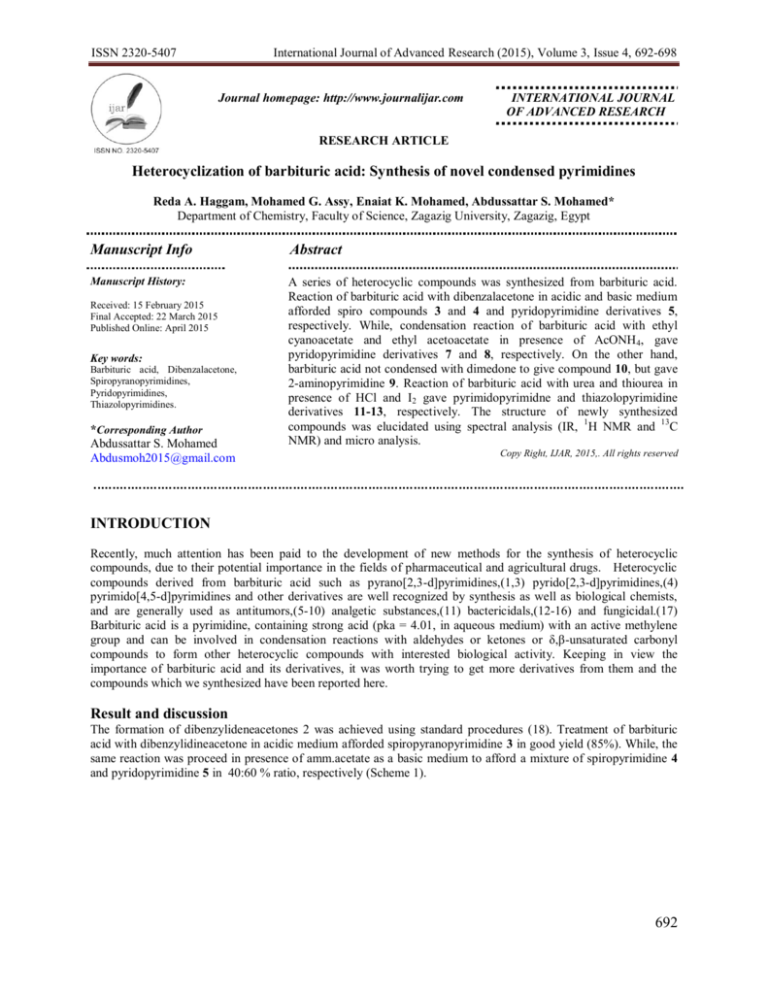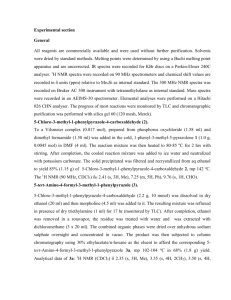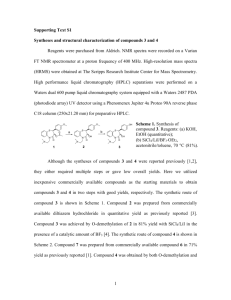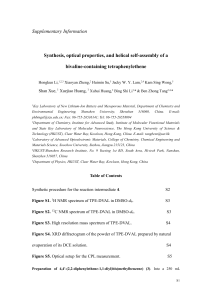
ISSN 2320-5407
International Journal of Advanced Research (2015), Volume 3, Issue 4, 692-698
Journal homepage: http://www.journalijar.com
INTERNATIONAL JOURNAL
OF ADVANCED RESEARCH
RESEARCH ARTICLE
Heterocyclization of barbituric acid: Synthesis of novel condensed pyrimidines
Reda A. Haggam, Mohamed G. Assy, Enaiat K. Mohamed, Abdussattar S. Mohamed*
Department of Chemistry, Faculty of Science, Zagazig University, Zagazig, Egypt
Manuscript Info
Abstract
Manuscript History:
A series of heterocyclic compounds was synthesized from barbituric acid.
Reaction of barbituric acid with dibenzalacetone in acidic and basic medium
afforded spiro compounds 3 and 4 and pyridopyrimidine derivatives 5,
respectively. While, condensation reaction of barbituric acid with ethyl
cyanoacetate and ethyl acetoacetate in presence of AcONH4, gave
pyridopyrimidine derivatives 7 and 8, respectively. On the other hand,
barbituric acid not condensed with dimedone to give compound 10, but gave
2-aminopyrimidine 9. Reaction of barbituric acid with urea and thiourea in
presence of HCl and I2 gave pyrimidopyrimidne and thiazolopyrimidine
derivatives 11-13, respectively. The structure of newly synthesized
compounds was elucidated using spectral analysis (IR, 1H NMR and 13C
NMR) and micro analysis.
Received: 15 February 2015
Final Accepted: 22 March 2015
Published Online: April 2015
Key words:
Barbituric acid, Dibenzalacetone,
Spiropyranopyrimidines,
Pyridopyrimidines,
Thiazolopyrimidines.
*Corresponding Author
Abdussattar S. Mohamed
Abdusmoh2015@gmail.com
Copy Right, IJAR, 2015,. All rights reserved
INTRODUCTION
Recently, much attention has been paid to the development of new methods for the synthesis of heterocyclic
compounds, due to their potential importance in the fields of pharmaceutical and agricultural drugs. Heterocyclic
compounds derived from barbituric acid such as pyrano[2,3-d]pyrimidines,(1,3) pyrido[2,3-d]pyrimidines,(4)
pyrimido[4,5-d]pyrimidines and other derivatives are well recognized by synthesis as well as biological chemists,
and are generally used as antitumors,(5-10) analgetic substances,(11) bactericidals,(12-16) and fungicidal.(17)
Barbituric acid is a pyrimidine, containing strong acid (pka = 4.01, in aqueous medium) with an active methylene
group and can be involved in condensation reactions with aldehydes or ketones or δ,β-unsaturated carbonyl
compounds to form other heterocyclic compounds with interested biological activity. Keeping in view the
importance of barbituric acid and its derivatives, it was worth trying to get more derivatives from them and the
compounds which we synthesized have been reported here.
Result and discussion
The formation of dibenzylideneacetones 2 was achieved using standard procedures (18). Treatment of barbituric
acid with dibenzylidineacetone in acidic medium afforded spiropyranopyrimidine 3 in good yield (85%). While, the
same reaction was proceed in presence of amm.acetate as a basic medium to afford a mixture of spiropyrimidine 4
and pyridopyrimidine 5 in 40:60 % ratio, respectively (Scheme 1).
692
ISSN 2320-5407
International Journal of Advanced Research (2015), Volume 3, Issue 4, 692-698
The structure assigned for the reaction product was established form the analytical and spectral data. The 1HNMR
spectrum of compound 3 showed pyran ring proton at δ = 5.90 ppm as singlet, and multiplet for aromatic protons at
δ = 6.98–7.16 ppm. In addition to, the two NH’s at δ = 10.00, δ = 12.00 ppm as singlet.
When the reaction of compound 1 and dibenzalacetone was conducted in acetic acid and ammonium acetate, this led
to formation two compounds 1,5 adduct 4 in addition to pyridopyrimidine 5. The 1HNMR of compound 4 revealed
two signals at δ = 2.49 ppm as doublet for CH2 and at δ = 3.24 ppm as triplet for CH of cyclohexyl protons. In
addition to, two signals at δ = 11.20, δ = 11.40 ppm for two NH’s protons. 1HNMR of compound 5 showed doublet
at δ = 3.25 ppm for CH2, triplet at δ = 3.90 ppm for CH, Moreover, the NH’s protons are found at δ = 11.15 and δ =
11.41 ppm (Scheme 3)
The suggested mechanism for the formation of both compound 4 and compound 5 may take place via initial Michael
addition of 1 to the activated C=C of dibenzalacetone to generate the intermediate A which then underwent
cyclohexane cyclization forming compound 4 via second intramoleculer Michael addition of methenyl barbituric
acid proton to α, β unsaturated system (Scheme 3). On the other hand, compound 5 was formed by amination of A,
followed by pyridine intramolecular cyclization giving pyridopyrimidine 5 (Scheme 3).
693
ISSN 2320-5407
International Journal of Advanced Research (2015), Volume 3, Issue 4, 692-698
Heterocyclization of benzalbarbituric acid with ethyl cyanoacetate and ethyl acetoacetate in presence of ammonium
acetate in acetic acid afforded pyridopyrimidine derivatives 7 and 8, respectively (Scheme 3). While carring out the
same reaction using dimedone, not cyclized to
the desired pyrimidoquinoline derivative 10, but gave 2aminopyrimidine derivative 9 (Scheme 3). The formation of 12 is potentiated by the presence of one C=O group
band in IR spectroscopy.
The 1HNMR of compound 8 showed signals at δ = 0.95 as triplet for CH 3, at δ = 4.10 as quartet for CH2, at δ = 4.20
as doublet for CH, at δ = 4.90 as doublet for CH and two signals to NH’s at δ = 11.40 and δ = 11.60 ppm.
694
ISSN 2320-5407
International Journal of Advanced Research (2015), Volume 3, Issue 4, 692-698
The reaction of benzalbarbituric acid 6 with urea and thiourea in presnce of HCl gave the corresponding
pyrimidopyrimidine derivatives 11 and 12, respectively (Scheme 3). While, the reaction of banzalbarbituric acid 6
with thiourea in presence of iodine gave thiazolopyrimidine 13 (Scheme 3). The spectral analysis of 11-13 was
agreement with their structures. The preparation of thiazolopyrimidine 13 may occur within the formation of alkyl
thiourea derivative through an oxidative alkylation followed by thiazolcyclization by intramolecular dehydration as
in (Scheme 4).
695
ISSN 2320-5407
International Journal of Advanced Research (2015), Volume 3, Issue 4, 692-698
Experimental
All melting points were determined with electro thermal IA 9100 series digital melting point apparatus and are
uncorrected. All experiments were carried out using drying solvents. The IR spectra were recorded on a ParkinElmer model 1600 FTIR spectrometer as KBr discs (USA). 1H, 13C NMR spectra were recorded with Brucker AC300 MHz spectrometer. Chemical shift are expressed as δ (ppm) scale relative to TMS as an internal standard and
DMSO-d6 as solvent. The elemental analyses were determined on a Parkin-Elmer model 240 at Micro-analytical
Center Cairo University.
5,5'-diphenyl-7,7'-spirobi[pyrano[2,3-d]pyrimidine]-2,2',4,4' (1H,1'H,3H,3'H)-tetraone (3) To a solution of
barbituric acid (1) (5.00 mmol), dibenzalacetone (5.00 mmol) and HCl (5.00 mmol) in ethanol (16 mL) and the
contents were refluxed for 6 h. The reaction mixture were concentrated by evaporation, cooled and poured into
crushed ice. The solid thus separated was filtered, washed with water, dried and crystallized from ethanol to give
compound 2 in 85 % yield as yellow crystals, Mp. 290–291 °C. IR (KBr): 3273 cm-1 (NH), 1623 cm-1 (C=O). 1H
NMR (300 MHz, DMSO-d6): δ = 5.90 (s, 1H, CH olefenic), 6.98–7.16 (m, 10H, ArH’s), 10.00 (s, 1H, NH), 12.00
(s, 1H, NH). 13C NMR (75 MHz, DMSO-d6): 21.1, 73.0, 91.0, 126.7, 127.4, 145.0, 150.7, 169.2, 172.1, 189.2,
190.1. Anal Calcd for C25H16N4O6 (468.42): C, 64.10; H, 3.44; N, 11.96. Found: C, 63.85; H, 3.29; N, 11.64.
7,11-diphenyl-2,4-diazaspiro[5,5]undecane-1,3,5,9-tetraone
(4)
and
(E)-5-phenyl-7-styryl-1,5,6,8atetrahydropyrido[2,3-d]pyrimidine-2,4 (3H,4aH)-dione (5) To a solution of barbituric acid (1) (50.0 mmol) and
dibenzalacetone (50.0 mmol) in glacial acetic acid (60 mL) ammonium acetate (50.0 mmol) was added. The reaction
mixture was refluxed for 6 h. Then it was concentrated, cooled and poured into crushed ice to give solid product
which was boiled in ethanol and filtered. The filtrate was left to cool then the formed precipitate was filtred and
crystallized from ethanol to give compound 4 in 40 % yield as white crystals, Mp. 240–241 °C. IR (KBr): 3402 cm-1
(NH), 1710 (C=O), 1599 (C=O). 1H NMR (300 MHz, DMSO-d6), δ = 2.49 (d, 1H, CH2), 3.24 (t, 1H, CH), 6.93–
7.37 (m, 10H, ArH’s), 11.20 (s, 1H, NH), 11.40 (s, 1H, NH). 13C NMR (75 MHz, DMSO-d6): δ = 49.0, 59.0, 127.9,
128.2, 128.8, 137.6, 148.9, 171.0, 172.0, 207.4. Anal Calcd for C21H18N2O4 (362.38): C, 69.60; H, 5.01; N, 7.73.
Found: C, 69.34; H, 4.81; N, 7.61.
696
ISSN 2320-5407
International Journal of Advanced Research (2015), Volume 3, Issue 4, 692-698
The residue was crystallized from DMF to give compound 5 in 60 % yield as pale yellow, Mp 270–271 °C. IR
(KBr): 3402 cm-1 (NH), 1710 (C=O), 1599 (C=O). 1H NMR (300 MHz, DMSO-d6): δ =3.25 (d, 2H, CH2), 3.90 (t,
2H, CH), 6.90–7.37 (m, 5H, ArH’s), 11.10 (s, 1H, NH), 11.40 (s, 1H, NH). Anal Calcd for C21H17N3O2 (343.38): C,
73.45; H, 4.99; N, 12.24. Found: C, 73.25; H, 4.72; N, 12.11.
7-amino-2,4-dioxo-5-phenyl-1,2,3,4-tetrahydropyrido[2,3-d]pyrimidine-6-carboxamide (7) A mixture of
benzalbarbituric acid (6) (5.00 mmol) and ethylcyanoacetat (5.00 mmol) in glacial acetic acid (25 mL) was added to
ammonium acetate (50.0 mmol). The reaction mixture was refluxed for 6 h and left to cool at room temperature. The
filtrated product was crystallized from ethanol to give compound 7 in 73 % yield as yellow crystals, Mp >300 °C. IR
(KBr): 3402 cm-1 (NH), 1689 cm-1 (C=O). 1H NMR (300 MHz, DMSO-d6): δ = 5.90 (s, 2H, NH2), 7.00–7.20 (m,
5H, ArH’s, and NH2), 9.90 (s, 1H, NH), 10.10 (s, 1H, NH). Anal Calcd for C14H11N5O3 (297.27): C, 56.56; H, 3.73;
N, 23.56. Found: C, 56.49; H, 3.50; N, 23.44.
Ethyl 7-methyl-2,4-dioxo-5-phenyl-1,2,3,4,5,6-hexahydropyrido[2,3-d] pyrimidine-6-carboxylate (8) A mixture
of benzalbarbituric acid (6) (10.0 mmol) and ethyl acetoacetat (10.0 mmol) in glacial acetic acid (30 mL)
ammonium acetate (50.0 mmol) was added. The reaction mixture was refluxed for 6 h. Then it was cooled and
poured into crushed ice to give solid product which was crystallized from acetic acid to give compound 8 in 80 %
yield as yellow crystals, Mp >300 °C. IR (KBr): 1712 cm-1 (C=O), 1660 cm-1 (C=O). 1H NMR (300 MHz, DMSOd6): δ = 0.95 (t, 3H, CH3), 4.10 (q, 2H, CH2O), 4.20 (d, 1H, CH), 4.90 (d, 1H, CH-C6H5), 7.10–7.30 (m, 5H, ArH’s),
11.40 (s, 1H, NH), 11.60 (s, 1H, NH). 13C NMR (75 MHz, DMSO-d6): δ = 13.8, 42.8, 49.0, 50.8, 58.9, 60.5, 127.8,
128.4, 136.6, 138.0, 148.8, 167.8, 170.9, 203.2, 207.3. Anal Calcd for C17H17N3O4 (327.33): C, 62.38; H, 5.23; N,
12.84. Found: C, 62.13; H, 5.04; N, 12.71.
2-Amino-5-benzylidenedihydropyrimidine-4,6-(1H,5H)-dione (9) A mixture of benzalbarbituric acid (6) (5.00
mmol) and dimedone (5.00 mmol) in glacial acetic acid (15 mL) was added to ammonium acetate (50.0 mmol). The
reaction mixture was refluxed for 5 h, then left to cool at room temperature. The mixture was poured into ice cooled
water. The separated solid was collected by filtration and crystallized from ethanol to give compound 9 in 78 %
yield as yellow crystals, Mp. >300 °C. IR (KBr): 3184 cm-1 (NH), 1691 cm-1 (C=O) 1604 (C=O). 1H NMR (300
MHz, DMSO-d6): δ =5.90 (S, 1H, CH), 7.00–7.16 (m, 5H, ArH’s), 9.90 (s, 1H, NH2), 11.10 (s, 1H, NH), 12.30 (s,
1H, NH). Anal Calcd for C11H11N3O2 (217.22): C, 60.82; H, 5.10; N, 19.34. Found: C, 60.58; H, 4.88; N, 19.12.
General procedure for synthesis of compounds (11 and 12) A mixture of benzalbarbituric acid (6) (10.0 mmol)
and urea (10.0 mmol) or thiourea (10.0 mmol) in the presence of HCl (0.53 mL) and acetic acid (10 mL) was
refluxed for 6 h. The mixture was concentrated and poured into crushed ice. The solid formed was filtred for
recrystallization.
5-Phenyl-5,6-dihydropyrimido[4,5-d]pyrimidine-2,4,7(1H,3H,8H)-trione (11) The filtrated product was
crystallized from ethanol to give compound 11 in 80 % yield as white crystals, Mp >300 °C. IR (KBr): 3190.32 cm-1
(NH), 1691.52 cm-1 (C=O). 1H NMR (300 MHz, DMSO-d6): δ = 5.90 (s, 1H, CH-C6H5), 6.90–7.60 (m, 5H, ArH’s),
8.00 (s, 1H, NH), 8.20 (s, 1H, NH), 10.00 (s, 1H, NH), 11.40 (s, 1H, NH). Anal Calcd for C12H10N4O3 (258.23): C,
55.81; H, 3.90; N, 18.59. Found: C, 55.63; H, 3.82; N, 21.45.
5-Phenyl-7-thioxo-5,6,7,8-tetrahydropyrimido[4,5-d]pyrimidine-2,4(1H,3H)-dione (12) The compound 12 was
obtained in similar way just replacement urea by thiourea and crystallized from ethanol to give compound 12 in 88
% yield as brown crystals, Mp >300 °C. IR (KBr): 3431.34 cm-1 (NH), 1693.86 cm-1 (C=O). 1H NMR (300 MHz,
DMSO-d6): δ =5.90 (s, 1H, CH-C6H5), 6.80–7.60 (m, 5H, ArH’s), 8.20 (s, 1H, NH), 10.00 (s, 1H, NH), 10.30 (s,
1H, NH), 10.70 (s, 1H, NH). Anal Calcd for C12H10N4O2S (274.30): C, 52.54; H, 3.67; N, 20.43. Found: C, 52.42;
H, 3.48; N, 20.24.
Imino-2,3-dihydrothiazolo[4,5-d]pyrimidine-5,7(4H,6H)-dione (13)
A mixture of benzalbarbituric acid (6) (10.0 mmol), thiourea(10.0 mmol) and iodine (10.0 mmol) in ethanol (15 mL)
was refluxed for 6 h. The reaction mixture was concentrated, cooled and poured into crushed ice. The seprated solid
was filtrated, washed with water and crystallized from ethanol to give compound 13 in 55 % yield as yellow
crystals, Mp. = 299–300 °C. IR (KBr): 3328 cm-1 (NH), 1704 cm-1 (C=O). 1H NMR (300 MHz, DMSO-d6): δ =
2.80 (s, 1H, NH), 9.40 (s, 1H, NH), 10.20 (s, 1H, NH), 11.00 (s, 1H, NH). Anal Calcd for C5H4N4O2S (184.18): C,
32.61; H, 2.19; N, 30.42. Found: C, 32.45; H, 2.10; N, 30.26.
697
ISSN 2320-5407
International Journal of Advanced Research (2015), Volume 3, Issue 4, 692-698
Conclusion
In summary, some novel condensed pyrimidine derivatives that are structurally related to known drugs pyrimidine
were synthesized via multicomponent one-pot reaction starting from barbituric acid and dibenzalacetone to produce
spiropyranopyrimidine, pyridopyrimidine, thiazolopyrimidine derivatives The experimental simplicity, excellent
product yield, shorter reaction time, and easy work-up procedure of MCRs make this approach more attractive for
synthesis a variety of such derivatives.
References
1. Heravi, M.M.; Ghods, A.; Derikvand, F.; Bakhtiari, K. and Bamoharram, F.F. J. Iran. Chem. Soc. 2010, 7, 3,
615-620.
2. Devi, I; Kumar, B.S.D; Bhuyan, P. J. Tetrahedron Letters. 2003, 44, 45, 8307-8310.
3. Quintela, J. M.; Peinador Carlos , Moreira M. J. Tetrahedron, 1995, 51, 20, 5901-5912.
4. Fares, M.; Abou-Seri, S.M.; Abdel-Aziz, H.; Abbas, S.; Youssef, M.M.; Eladwy, R.A. Eur. J. Med. Chem. 2014,
83, 155–166.
5. Suguira, K.; Schmid, A.F.; Schmid, M.M.; Brown, F.G. Cancer Chemother. Rep. Part 2 1973, 3 (1), 231.
6. Rhee, H.K.; Yoo, J.H.; Lee, E.; Kwon, Y.J.; Seo, H.R.; Lee, Y.S.; Choo, H.Y. Eur. J. Med. Chem. 2011, 46,
3900-3908.
7. Jiang, N.; Zhai, X.; Zhao, Y.; Liu, Y.; Qi, B.; Tao, H.; Gong, P. Eur. J. Med. Chem. 2012, 54, 534-541.
8. Al-Omary, F.A.M.; Hassan, G.S.; El-Messery, S.M.; El-Subbagh, H.I. Eur. J. Med. Chem. 2012, 47, 65–72.
9. Liu, Z.; Wu, S.; Wang, Y.; Li, R.; Wang, J.; Wang, L.; Zhao, Y.; Gong, P. Eur. J. Med. Chem. 2014, 87, 782–93.
10. Das, S.; Chatterjee, N.; Bose, D.; Dey, S.K.; Munda, R.N.; Nandy, A.; Bera, S.; Biswas, S.K.; Das Saha, K. Cell.
Physiol. Biochem. 2012, 29, 251-260.
11. Regnier, G.L.; Canevar, R.J.; Le Douarec, J.C.; Halstop, S.; Daussy, J. J. Med. Chem. 1972, 15, 295.
12. Hilmy, K.M.H.; Khalifa, M.M.A.; Hawata, M.A.A.; Keshk, R.M.A.; El-Torgman, A.A. Eur. J. Med. Chem.
2010, 45, 5243–5250.
13. Bhalgat, C.M.; Ramesh, B. Bull. Fac. Pharmacy, Cairo Univ. 2014, 52, 259–267.
14. Saikia, L.; Das, B.; Bharali, P.; Thakur, A.J. Tetrahedron Lett. 2014, 55, 1796–1801.
15. Al-Adiwish, W.M.; Tahir, M.I.M.; Siti-Noor-Adnalizawati, A.; Hashim, S.F.; Ibrahim, N.; Yaacob, W. Eur. J.
Med. Chem. 2013, 64, 464–476.
16. Pershin, N.G.; Sherbakova, L.I.; Zykova, T.N.; Sakolova, V.N. Farmakol. Taksikol. 1972, 35, 466.
17. Metolcsy, G. World Rev. Pest Contr. 1971, 10, 50 (Chem. Abstr. 1972, 76, 82031s).
18. Organic Chemistry laboratory textbooks and online editions, Dibenzalacetone by aldo condensation
698



![Synthesis of [ChCl][ZnCl2]2 ionic liquid 1 mmol of choline chloride](http://s3.studylib.net/store/data/006941233_1-367e4dc6f52fe7a83ef718561a45342d-300x300.png)





